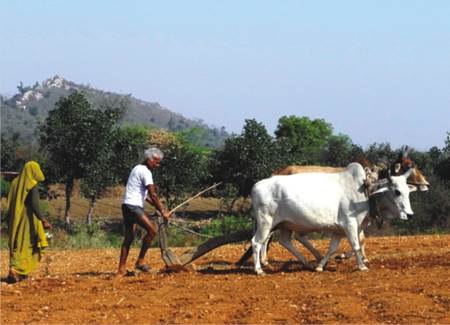|
Planting Wadis Improves
Lives of Small Holder Farmers "T he Wadi programme came as a ray of hope for me and my family when I became associated with it in 2010” says Bhunna Sahariya, a Sahariya tribal farmer of Rasina village in the Babina block of the Jhansi district in Uttar Pradesh. Prior to 2010, his field produced a scanty and poor quality crop, as he had no irrigation facilities. This forced Bhunna Sahariya to regularly migrate with his family for a couple of months to cities like Bhopal and Jhansi in search of work as a daily wage labourer. As a result, his children could not attend school regularly and eventually dropped out.In 2010, Development Alternatives (DA) with support from the National Bank for Rural and Agriculture Development (NABARD) initiated the Wadi programme, an agro-horti based livelihood development model in Rasina village. Bhunna Sahariya was one of the farmers who joined this programme. At first, he was reluctant to join as investing in the wadi would not provide immediate financial returns for him. Working as a wage labourer helped him meet his daily household expenses. To address this problem, Development Alternatives first started with getting Bhunna Sahariya to dig pits on his land for planting guava and gooseberry (amla) trees. He received Rs.25 per pit for digging 110 pits. This monetary gain motivated Bhunna Sahariya to continue work on the wadi and not migrate. Eventually, he planted 55 guava and 55 gooseberry (amla) trees in his one acre of wasteland. After a year, he made a profit of Rs. 10,000 from his land by intercropping the fruit trees with pulses. The following year, he made a profit of Rs. 12,000 by growing vegetables on his land along with the trees and the pulses. Bhunna Sahariya’s investment in the wadi programme not only benefitted his family, but also the entire village because not only did a wasteland get converted into fertile land, but it also increased the ground water level of the entire area. Before the wadi programme, his village did not have regular supply of water for household and farm use. People would fetch water from as far as 2 km every day. Under the wadi programme, Bhunna Sahariya dug a borewell in his field which ensured regular water for irrigating his wadi. The villagers attached a pipeline to this borewell which helped in ensuring a constant supply of water to the households of Rasina village. Witnessing the success of Bhuna Sahariya’s wadi, other farmers from his village have also started planting wadis. Apart from economic and environmental gains, the Wadi programme also resulted in other behavioural changes and social benefits for Bhunna Sahariya. He proudly claims that his personality got transformed for the better. He has become a more confident, motivated and optimistic person than before. Moreover as he has stopped seasonal migration for work, it has enabled him to send his children to school regularly for the last three years. Today, he is a very active member of the Sahariya Vikas Manch (a federation of local farmers) promoting wadi development in the region. q |
|
Sustainable Agriculture – food security in a changing climate
|
|
S.B. Pandey
|
 A
growing population and changing dietary habits are placing increasing
demands on land for intensive food production. At the same time,
changing climate, over- cropping, increased fertilizer application and
resource mismanagement have led to land and water degradation with
consequent impacts on food quantity and quality. The variability in
global food prices coupled with uncertainties in weather patterns affect
small and marginal farmers disproportionately making them extremely
vulnerable to sudden shocks. Meeting present and future demands of food
and nutrition and sustaining agricultural livelihoods would require a
transition towards more robust agriculture practices – green technology
options, crop rotations, sound soil and water management, reduced
wastage and diversity in food consumption habits.
A
growing population and changing dietary habits are placing increasing
demands on land for intensive food production. At the same time,
changing climate, over- cropping, increased fertilizer application and
resource mismanagement have led to land and water degradation with
consequent impacts on food quantity and quality. The variability in
global food prices coupled with uncertainties in weather patterns affect
small and marginal farmers disproportionately making them extremely
vulnerable to sudden shocks. Meeting present and future demands of food
and nutrition and sustaining agricultural livelihoods would require a
transition towards more robust agriculture practices – green technology
options, crop rotations, sound soil and water management, reduced
wastage and diversity in food consumption habits.